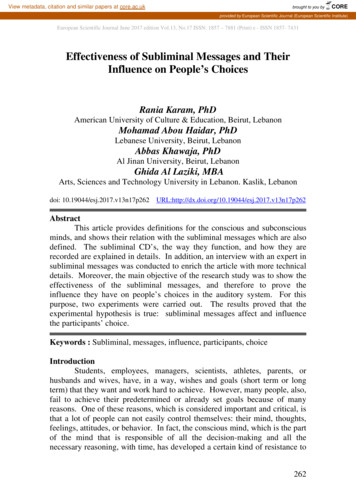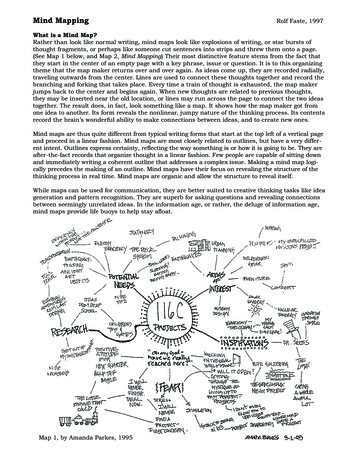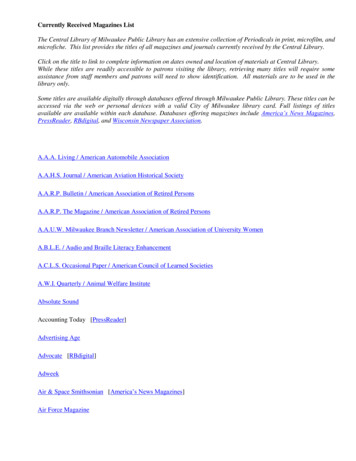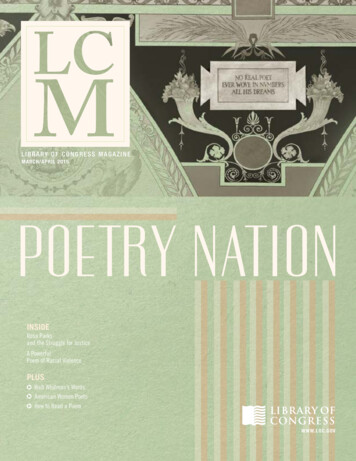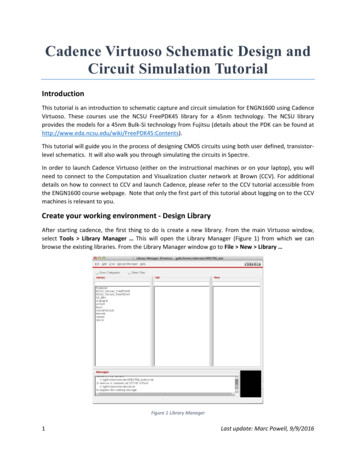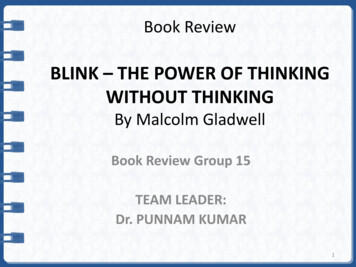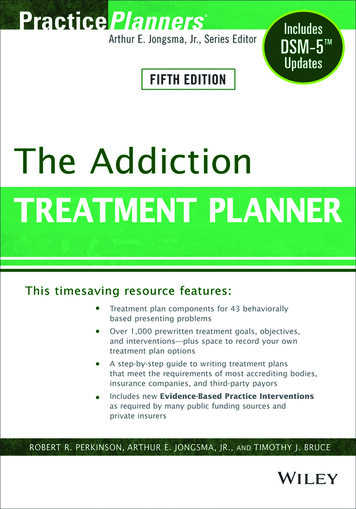
Transcription
The Addiction TreatmentPlanner,Fifth Edition
PracticePlanners SeriesTreatment PlannersThe Complete Adult Psychotherapy Treatment Planner, Fifth EditionThe Child Psychotherapy Treatment Planner, Fifth EditionThe Adolescent Psychotherapy Treatment Planner, Fifth EditionThe Addiction Treatment Planner, Fifth EditionThe Continuum of Care Treatment PlannerThe Couples Psychotherapy Treatment Planner, Second EditionThe Employee Assistance Treatment PlannerThe Pastoral Counseling Treatment PlannerThe Older Adult Psychotherapy Treatment Planner, Second EditionThe Behavioral Medicine Treatment PlannerThe Group Therapy Treatment PlannerThe Gay and Lesbian Psychotherapy Treatment PlannerThe Family Therapy Treatment Planner, Second EditionThe Severe and Persistent Mental Illness Treatment Planner, Second EditionThe Mental Retardation and Developmental Disability Treatment PlannerThe Social Work and Human Services Treatment PlannerThe Crisis Counseling and Traumatic Events Treatment Planner, Second EditionThe Personality Disorders Treatment PlannerThe Rehabilitation Psychology Treatment PlannerThe Special Education Treatment PlannerThe Juvenile Justice and Residential Care Treatment PlannerThe School Counseling and School Social Work Treatment Planner, Second EditionThe Sexual Abuse Victim and Sexual Offender Treatment PlannerThe Probation and Parole Treatment PlannerThe Psychopharmacology Treatment PlannerThe Speech-Language Pathology Treatment PlannerThe Suicide and Homicide Treatment PlannerThe College Student Counseling Treatment PlannerThe Parenting Skills Treatment PlannerThe Early Childhood Intervention Treatment PlannerThe Co-Occurring Disorders Treatment PlannerThe Complete Women’s Psychotherapy Treatment PlannerThe Veterans and Active Duty Military Psychotherapy Treatment PlannerProgress Notes PlannersThe Child Psychotherapy Progress Notes Planner, Fifth EditionThe Adolescent Psychotherapy Progress Notes Planner, Fifth EditionThe Adult Psychotherapy Progress Notes Planner, Fifth EditionThe Addiction Progress Notes Planner, Fifth EditionThe Severe and Persistent Mental Illness Progress Notes Planner, Second EditionThe Couples Psychotherapy Progress Notes Planner, Second EditionThe Family Therapy Progress Notes Planner, Second EditionThe Veterans and Active Duty Military Psychotherapy Progress Notes PlannerHomework PlannersCouples Therapy Homework Planner, Second EditionFamily Therapy Homework Planner, Second EditionGrief Counseling Homework PlannerGroup Therapy Homework PlannerDivorce Counseling Homework PlannerSchool Counseling and School Social Work Homework Planner, Second EditionChild Therapy Activity and Homework PlannerAddiction Treatment Homework Planner, Fifth EditionAdolescent Psychotherapy Homework Planner, Fifth EditionAdult Psychotherapy Homework Planner, Fifth EditionChild Psychotherapy Homework Planner, Fifth EditionParenting Skills Homework PlannerVeterans and Active Duty Military Psychotherapy Homework PlannerClient Education Handout PlannersAdult Client Education Handout PlannerChild and Adolescent Client Education Handout PlannerCouples and Family Client Education Handout PlannerComplete PlannersThe Complete Depression Treatment and Homework PlannerThe Complete Anxiety Treatment and Homework Planner
PracticePlanners Arthur E. Jongsma, Jr., Series EditorThe AddictionTreatment Planner,Fifth EditionRobert R. PerkinsonArthur E. Jongsma, Jr.Timothy J. Bruce
Cover image: Ryan McVay/Getty ImagesCover design: WileyThis book is printed on acid-free paper.Copyright 2014 by Robert R. Perkinson, Arthur E. Jongsma, Jr., and Timothy J. Bruce. All rightsreserved.Published by John Wiley & Sons, Inc., Hoboken, New JerseyPublished simultaneously in CanadaNo part of this publication may be reproduced, stored in a retrieval system, or transmitted in any form orby any means, electronic, mechanical, photocopying, recording, scanning, or otherwise, except aspermitted under Section 107 or 108 of the 1976 United States Copyright Act, without either the priorwritten permission of the Publisher, or authorization through payment of the appropriate per-copy fee tothe Copyright Clearance Center, 222 Rosewood Drive, Danvers, MA 01923, (978) 750-8400, fax (978)646-8600, or on the web at www.copyright.com. Requests to the Publisher for permission should beaddressed to the Permissions Department, John Wiley & Sons, Inc., 111 River Street, Hoboken, NJ07030, (201) 748-6011, fax (201) 748-6008, or online at www.wiley.com/go/permissions.Limit of Liability/Disclaimer of Warranty: While the publisher and author have used their best efforts inpreparing this book, they make no representations or warranties with the respect to the accuracy orcompleteness of the contents of this book and specifically disclaim any implied warranties ofmerchantability or fitness for a particular purpose. No warranty may be created or extended by salesrepresentatives or written sales materials. The advice and strategies contained herein may not be suitablefor your situation. You should consult with a professional where appropriate. Neither the publisher northe author shall be liable for damages arising herefrom.For general information about our other products and services, please contact our Customer CareDepartment within the United States at (800) 762-2974, outside the United States at (317) 572-3993 orfax (317) 572-4002.Wiley publishes in a variety of print and electronic formats and by print-on-demand. Some materialincluded with standard print versions of this book may not be included in e-books or in print-on-demand.If this book refers to media such as a CD or DVD that is not included in the version you purchased, youmay download this material at http://booksupport.wiley.com. For more information about Wileyproducts, visit www.wiley.com.Library of Congress Cataloging-in-Publication Data:Perkinson, Robert R., author.The addiction treatment planner.—Fifth edition / Robert R. Perkinson, Arthur E. Jongsma, Jr.,Timothy J. Bruce.pages cm.—(Practice planners series)Includes bibliographical references.ISBN 978-1-118-41475-0 (pbk. : acid-free paper)ISBN 978-1-118-81695-0 (ebk.)ISBN 978-1-118-81700-1(ebk.)1. Substance abuse—Treatment—Handbooks, manuals, etc. 2. Substance abuse—Treatment—Planning—Handbooks, manuals, etc. I. Jongsma, Arthur E., Jr., 1943- author. II. Bruce, Timothy J.,author. III. Title.RC564.15.P47 2014362.29—dc232013034143Printed in the United States of America10 9 8 7 6 5 4 3 2 1
To Tom Moore, who has dedicated his career to bringing high-qualitytreatment to persons with substance use disorders.—A.E.J.To Shane, Nyshie, and Robert, three of the world-changing best.—R.R.P.To all those who struggle with addiction, and those who dedicate their livesin service to them.—T.J.B.
CONTENTSContents Listed by ASAM Assessment DimensionsPracticePlanners Series PrefaceIntroductionSample Treatment PlanAdult-Child-of-an-Alcoholic (ACA) Traits (Dimension 3)Anger (Dimension 3)Antisocial Behavior (Dimension 3)Anxiety (Dimension 3)Attention-Deficit/HyperactivityDisorder (ADHD)—Adolescent (Dimension 3)Attention-Deficit/HyperactivityDisorder (ADHD)—Adult (Dimension 3)Bipolar Disorder (Dimension 3)Borderline Traits (Dimension 3)Childhood Trauma (Dimension 3)Chronic Pain (Dimension 2)Conduct Disorder/Delinquency (Dimension 3)Dangerousness/Lethality (Dimension 3)Dependent Traits (Dimension 3)Eating Disorders and Obesity (Dimension 3)Family Conflicts (Dimension 3)Gambling (Dimension 3)Grief/Loss Unresolved (Dimension 3)Impulsivity (Dimension 3)Legal Problems (Dimension 3)Living Environment Deficiency (Dimension 6)Medical Issues (Dimension 2)Narcissistic Traits (Dimension 3)Nicotine Abuse/Dependence (Dimension 1)Obsessive-Compulsive Disorder (OCD) (Dimension 3)Occupational Problems (Dimension 6)Oppositional Defiant Behavior (Dimension 3)Parent–Child Relational Problem (Dimension 00210219228235243251259270280289301ix
xCONTENTSPartner Relational Conflicts (Dimension 6)Peer Group Negativity (Dimension 6)Posttraumatic Stress Disorder (PTSD); (Dimension 3)Psychosis (Dimension 3)Relapse Proneness (Dimension 5)Self-Care Deficits—Primary (Dimension 3)Self-Care Deficits—Secondary (Dimension 3)Self-Harm (Dimension 3)Sexual Abuse (Dimension 3)Sexual Promiscuity (Dimension 3)Sleep Disturbance (Dimension 3)Social Anxiety (Dimension 3)Spiritual Confusion (Dimension 3)Substance-Induced Disorders (Dimension 1)Substance Intoxication/Withdrawal (Dimension 1)Substance Use Disorders (Dimension 1)Suicidal Ideation (Dimension 3)Treatment Resistance (Dimension 4)Unipolar Depression (Dimension 485494502Appendix A: Bibliotherapy SuggestionsAppendix B: References to Empirical Support andClinical Resources for Evidence-Based ChaptersAppendix C: Recovery Model Objectives and InterventionsAppendix D: Client Satisfaction Surveys: Resource MaterialAppendix E: ASAM Six Assessment Dimensions: A ChecklistExampleAppendix F: Alphabetical Index of Sources for AssessmentInstruments and Clinical Interview Forms Cited inInterventions516553616623625632
CONTENTS LISTED BY ASAMASSESSMENT DIMENSIONSDimension 1: Acute Intoxication and/or Withdrawal PotentialNicotine Abuse/DependenceSubstance-Induced DisordersSubstance Intoxication/WithdrawalSubstance Use Disorders259454462470Dimension 2: Biomedical Conditions and ComplicationsChronic PainMedical Issues127243Dimension 3: Emotional, Behavioral, or Cognitive Conditions andComplicationsAdult-Child-of-an-Alcoholic (ACA) TraitsAngerAntisocial BehaviorAnxietyAttention-Deficit/Hyperactivity Disorder (ADHD)—AdolescentAttention-Deficit/Hyperactivity Disorder (ADHD)—AdultBipolar DisorderBorderline TraitsChildhood TraumaConduct nt TraitsEating Disorders and ObesityFamily ConflictsGamblingGrief/Loss UnresolvedImpulsivityLegal ProblemsNarcissistic TraitsObsessive-Compulsive Disorder (OCD)Oppositional Defiant BehaviorPosttraumatic Stress Disorder 228251270289330xi
xiiCONTENTS LISTED BY ASAM ASSESSMENT DIMENSIONSPsychosisSelf-Care Deficits—PrimarySelf-Care Deficits—SecondarySelf-HarmSexual AbuseSexual PromiscuitySleep DisturbanceSocial AnxietySpiritual ConfusionSuicidal IdeationUnipolar on 4: Readiness to ChangeTreatment Resistance494Dimension 5: Relapse, Continued Use, or Continued Problem PotentialRelapse Proneness357Dimension 6: Recovery/Living EnvironmentLiving Environment DeficiencyOccupational ProblemsParent–Child Relational ProblemPartner Relational ConflictsPeer Group Negativity235280301312322
PRACTICEPLANNERS SERIES PREFACEAccountability is an important dimension of the practice of psychotherapy.Treatment programs, public agencies, clinics, and practitioners must justifyand document their treatment plans to outside review entities in order to bereimbursed for services. The books in the PracticePlanners series aredesigned to help practitioners fulfill these documentation requirementsefficiently and professionally.The PracticePlanners series includes a wide array of treatment planningbooks including not only the original Complete Adult PsychotherapyTreatment Planner, Child Psychotherapy Treatment Planner, and AdolescentPsychotherapy Treatment Planner, all now in their fifth editions, but alsoTreatment Planners targeted to specialty areas of practice, including: AddictionsCo-occurring disordersBehavioral medicineCollege studentsCouples therapyCrisis counselingEarly childhood educationEmployee assistanceFamily therapyGays and lesbiansGroup therapyJuvenile justice and residential careMental retardation and developmental disabilityNeuropsychologyOlder adultsParenting skillsPastoral counselingPersonality disordersProbation and parolePsychopharmacologyRehabilitation psychologySchool counseling and school social workSevere and persistent mental illnessSexual abuse victims and offendersSocial work and human servicesxiii
xiv PRACTICEPLANNERS SERIES PREFACESpecial educationSpeech-language pathologySuicide and homicide risk assessmentVeterans and active military dutyWomen’s issuesIn addition, there are three branches of companion books that can be used inconjunction with the Treatment Planners, or on their own: Progress Notes Planners provide a menu of progress statements thatelaborate on the client’s symptom presentation and the provider’stherapeutic intervention. Each Progress Notes Planner statement isdirectly integrated with the behavioral definitions and therapeuticinterventions from its companion Treatment Planner.Homework Planners include homework assignments designed aroundeach presenting problem (such as anxiety, depression, chemicaldependence, anger management, eating disorders, or panic disorder)that is the focus of a chapter in its corresponding Treatment Planner.Client Education Handout Planners provide brochures and handouts tohelp educate and inform clients on presenting problems and mental healthissues, as well as life skills techniques. The handouts are included on CDROMs for easy printing from your computer and are ideal for use inwaiting rooms, at presentations, as newsletters, or as information for clientsstruggling with mental illness issues. The topics covered by these handoutscorrespond to the presenting problems in the Treatment Planners.The series also includes adjunctive books, such as The PsychotherapyDocumentation Primer and The Clinical Documentation Sourcebook, containforms and resources to aid the clinician in mental health practicemanagement.The goal of our series is to provide practitioners with the resources theyneed in order to provide high-quality care in the era of accountability. To putit simply: We seek to help you spend more time on patients and less time onpaperwork.ARTHUR E. JONGSMA, JR.Grand Rapids, Michigan
INTRODUCTIONABOUT PRACTICEPLANNERS TREATMENTPLANNERSPressure from third-party payors, accrediting agencies, and other outsideparties has increased the need for clinicians to quickly produce effective,high-quality treatment plans. Treatment Planners provide all the elementsnecessary to quickly and easily develop formal treatment plans that satisfythe needs of most third-party payors and state and federal review agencies.Each Treatment Planner Saves you hours of time-consuming paperwork.Offers the freedom to develop customized treatment plans.Includes over 1,000 clear statements describing the behavioral manifestations of each relational problem, and includes long-term goals, shortterm objectives, and clinically tested treatment options.Has an easy-to-use reference format that helps locate treatment plancomponents by behavioral problem or psychiatric diagnosis.As with the rest of the books in the PracticePlanners series, our aim isto clarify, simplify, and accelerate the treatment planning process so youspend less time on paperwork and more time with your clients.ABOUT THE ADDICTION TREATMENT PLANNERThe Addiction Treatment Planner has been written for individual, group, andfamily counselors and psychotherapists who are working with adults andadolescents who are struggling with addictions to mood-altering chemicals,gambling, abusive eating, nicotine, or sexual promiscuity. The problem listof chapter titles reflects those addictive behaviors and the emotional,behavioral, interpersonal, social, personality, legal, medical, and vocationalissues associated with those addictions. Whereas the focus of the originalChemical Dependence Treatment Planner was limited exclusively to substance1
2THE ADDICTION TREATMENT PLANNERabuse and its associated problems, the focus of later editions has beenexpanded to include other common addictive behaviors as well as otherbehavioral problems and psychiatric conditions in which addictive behaviormay occur.This fifth edition of The Addition Treatment Planner has been improvedin many ways: Updated with new and revised evidence-based objectives and interventionsRevised, expanded, and updated professional references (Appendix B)Revised, expanded, and updated the self-help book list in the bibliotherapy suggestions (Appendix A)More suggested homework assignments integrated into the interventionsNew recovery model (Appendix C) listing Goals, Objectives, andInterventions, allowing a more pointed integration of a recovery modelorientation into treatment plansNew Appendix F, which provides an alphabetical index of sources forthe assessment instruments and clinical interview forms that have beencited in chapter interventionsNew chapters on Obsessive-Compulsive Disorder, Self-Harm, SexualAbuse, and Sleep Disturbance; new objectives and interventions addressingobesity added into the Eating Disorders chapter; and reorganized chaptersincluding Bipolar Disorder and Unipolar DepressionIntegrated DSM-5 (ICD-10-CM) diagnostic labels and codes into theDiagnostic Suggestions section of each chapterThis edition of the Planner continues to give special attention to the PatientPlacement Criteria (PPC) developed by the American Society of AddictionMedicine (ASAM). In the ASAM contents we have listed our presentingproblem chapters under each of the six assessment dimensions:Dimension 1: Acute intoxication and/or withdrawal potentialDimension 2: Biomedical conditions and complicationsDimension 3: Emotional, behavioral, or cognitive conditions andcomplicationsDimension 4: Readiness to changeDimension 5: Relapse, continued use, or continued problem potentialDimension 6: Recovery/living environmentThe Addiction Treatment Planner has treatment planning content applicableto problems discovered in all of the six assessment dimensions.Also included (Appendix E) is a form that can be used to assess the clientunder the six ASAM dimensions. The checklist provides material forefficient evaluation of the client on each of the six dimensions. This form hasbeen developed and is utilized by the staff at Keystone Treatment Center,
INTRODUCTION3Canton, South Dakota, where Dr. Perkinson is the clinical director. It is notcopyrighted and may be used or adopted for use by our readers.Interventions can be found in each chapter that reflect a 12-step recoveryprogram approach, but you will also find interventions based on a broaderpsychological and pharmacological model. Because addiction treatment isoften done in a residential setting through a team approach, interventionshave been created that can be assigned to staff members of variousdisciplines and modalities: nursing, medical, group counseling, familytherapy, or individual therapy. We hope that we have provided a broad,eclectic menu of objectives and interventions from which you can select tomeet your client’s unique needs. Hopefully, we have also provided a stimulusfor you to create new objectives and interventions from your own clinicalexperience that have proven to be helpful to addictive clients.Evidence-based practice (EBP) is steadily becoming the standard of carein mental health care and addiction treatment as it has in medical healthcare. Professional organizations such as the American PsychologicalAssociation, National Association of Social Workers, Substance Abuse andMental Health Services Administration (SAMHSA), and the AmericanPsychiatric Association, as well as consumer organizations such the NationalAlliance for the Mentally Ill (NAMI) have endorsed the use of EBP. In somepractice settings, EBP is becoming mandated. It is clear that the call forevidence and accountability is being increasingly sounded. So, what is EBPand how is its use facilitated by this Planner?Borrowing from the Institute of Medicine’s definition (Institute ofMedicine, 2001), the American Psychological Association (APA) has definedEBP as “the integration of the best available research with clinical expertisein the context of patient characteristics, culture, and preferences” (APAPresidential Task Force on Evidence-Based Practice, 2006). Consistent withthis definition, we have identified those psychological treatments with thebest available supporting evidence, added Objectives and Interventionsconsistent with them in the pertinent chapters, and identified these with thissymbol: . As most practitioners know, research has shown that althoughthese treatment methods have demonstrated efficacy (e.g., Nathan & Gorman,2007), the individual psychologist (e.g., Wampold, 2001), the treatmentrelationship (e.g., Norcross, 2002), and the patient (e.g., Bohart & Tallman,1999) are also vital contributors to the success of psychotherapy. As noted bythe APA, “Comprehensive evidence-based practice will consider all of thesedeterminants and their optimal combinations” (APA, 2006, p. 275). For moreinformation and instruction on constructing evidence-based psychotherapytreatment plans, see our DVD-based training series entitled Evidence-BasedPsychotherapy Treatment Planning (Jongsma & Bruce, 2010–2012).The sources listed in the professional references in Appendix B and usedto identify the evidence-based treatments integrated into this Planner aremany. They include supportive studies from the treatment outcomeliterature; current expert individual, group, and organizational reviews; and
4THE ADDICTION TREATMENT PLANNEREBP guideline recommendations. Examples of specific sources used includethe Cochrane Collaboration reviews, the work of the Society of ClinicalPsychology (Division 12 of the American Psychological Association)identifying research-supported psychological treatments, evidence-basedtreatment reviews such as those in Nathan and Gorman’s A Guide toTreatments That Work and SAMHSA’s National Registry of EvidenceBased Programs and Practices (NREPP), and EBP guidelines fromprofessional organizations such as the American Psychiatric Association, theNational Institute for Health and Clinical Excellence in Great Britain, theNational Institute on Drug Abuse (NIDA), and the Agency for HealthcareResearch and Quality (AHRQ), to name a few. Although each of thesesources uses its own criteria for judging levels of empirical support for anygiven treatment, we favored those that use more rigorous criteria typicallyrequiring demonstration of efficacy through randomized controlled trials orclinical replication series, good experimental design, and independentreplication. Our approach was to evaluate these various sources and includethose treatments supported by the highest level of evidence and for whichthere was consensus in conclusions and/or recommendations. For anychapter in which EBP is indicated, references to the sources used to identifyindicated treatments are listed in the professional references (Appendix B),and can be consulted by those interested in further information regardingcriteria and conclusions. In addition to these references, this appendix alsoincludes references to clinical resources. Clinical resources are books,manuals, and other resources for clinicians that describe the details of theapplication or “how to” of the treatment approaches described in a chapter.There is debate regarding EBP among mental health professionals whoare not always in agreement regarding the best treatment or how to weighthe factors that contribute to good outcomes. Some practitioners areskeptical about changing their practice on the basis of research evidence, andtheir reluctance is fuelled by the methodological challenges and problemsinherent in researching psychotherapy. Our intent in this book is toaccommodate these differences by providing a range of treatment planoptions, some supported by the evidence-based value of “best availableresearch” (APA, 2006), others reflecting common clinical practices ofexperienced clinicians, and still others representing emerging approaches sothe users, in consideration of their personal clinical expertise and in thecontext of client characteristics, culture, and preferences, can construct whatthey believe to be the best plan for their particular client.Each of the chapters in this edition has also been reviewed with the goalof integrating homework exercise options into the interventions. Many of theclient homework exercise suggestions were taken from and can be found inthe Addiction Treatment Homework Planner (Finley & Lenz, 2014) and theAdult Psychotherapy Homework Planner (Jongsma, 2014). You will findmany more homework assignments suggested in this fifth edition of TheAddiction Treatment Planner than in previous editions.
INTRODUCTION5The bibliotherapy suggestions listed in Appendix A of this Planner havebeen significantly expanded and updated from previous editions. Theappendix includes many recently published offerings as well as more recenteditions of books cited in our earlier editions. All of the self-help books andclient workbooks cited in the chapter interventions are listed in thisappendix. There are also many additional books listed that are supportive ofthe treatment approaches described in the respective chapters. Each chapterhas a list of self-help books consistent with it listed in this appendix.In its final report entitled Achieving the Promise: Transforming MentalHealth Care in America, the president’s New Freedom Commission onMental Health called for recovery to be the “common, recognized outcomeof mental health services” (New Freedom Commission on Mental Health,2003). To define recovery, SAMHSA within the U.S. Department of Healthand Human Services and the Interagency Committee on Disability Researchin partnership with six other federal agencies convened the NationalConsensus Conference on Mental Health Recovery and Mental HealthSystems Transformation (SAMHSA, 2004). Over 110 expert panelistsparticipated, including mental health consumers, family members, providers,advocates, researchers, academicians, managed care representatives,accreditation bodies, state and local public officials, and others. From thesedeliberations, the following consensus statement was derived:Mental health recovery is a journey of healing and transformation for aperson with a mental health problem to be able to live a meaningful life in acommunity of his or her choice while striving to achieve maximum humanpotential. Recovery is a multi-faceted concept based on the following 10fundamental elements and guiding principles: Self-directionIndividualized and hs-basedPeer supportRespectResponsibilityHopeThese recovery model principles are defined in Appendix C. We havealso created a set of Goal, Objective, and Intervention statements that reflectthese 10 principles. The clinician who desires to insert into the clienttreatment plan specific statements reflecting a Recovery Model orientationmay choose from this list.In addition to this list, we believe that many of the Goal, Objective, andIntervention statements found in the chapters reflect a recovery orientation.
6THE ADDICTION TREATMENT PLANNERFor example, our assessment interventions are meant to identify how theproblem affects this unique client and the strengths that the client brings tothe treatment. Additionally, an intervention statement such as, “Help theclient to see the new hope that addiction treatment brings to the resolution ofinterpersonal conflicts” from the “Suicidal Ideation” chapter is evidence thatrecovery model content, such as the principle of hope, permeates items listedthroughout our chapters. However, if the clinician desires a more focused setof statements directly related to each principle guiding the recovery model,they can be found in Appendix C.We have done a bit of reorganizing of chapter content for this edition.We have renamed the “Depression” chapter to become “UnipolarDepression.” A new chapter entitled “Bipolar Disorder” replaces theprevious one entitled “Mania/Hypomania” and now includes interventionsfor bipolar depression as well as hypomania and mania. We have alsodeleted the previous chapter entitled “Opioid Dependence” and subsumed itscontent under a newly titled chapter called “Substance Use Disorders.” The“Substance Use Disorders” chapter replaces the previous chapter entitled“Substance Abuse/Dependence,” which is in accord with the new DSM-5nomenclature and is now more broadly applicable to many types of abuseand dependence. Lastly, we deleted the chapter titled “AttentionDeficit/Inattentive Disorder (ADD)” and subsumed much of its contentunder the two continuing chapters entitled “Attention-Deficit/HyperactivityDisorder (ADHD)—Adolescent” and “Attention-Deficit/HyperactivityDisorder (ADHD)—Adult.”With the publication of the DSM-5 (APA, 2013), we have updated theDiagnostic Suggestions section at the end of each chapter. The DSM-IV-TR(APA, 2000) was used in previous editions of this Planner. Although many ofthe diagnostic labels and codes remain the same, several have changed withthe publication of the DSM-5 and are reflected in this Planner. We havecontinued to list DSM-IV (ICD-9-CM) codes and diagnostic labels whileadding a section of DSM-5 (ICD-10-CM) codes and labels describing thedisorder, condition, or problem. The date currently set for mandatory use ofDSM-5 (ICD-10-CM) codes and labels for billing purposes is October 2014.At the end of each chapter’s list of objectives and interventions there is areference to administration of a client satisfaction survey. Appendix Dcontains resource material for examples of various types of satisfactionassessment instruments.Lastly, some clinicians have asked that the objective statements in thisPlanner be written such that the client’s attainment of the objective can bemeasured. We have written our objectives in behavioral terms and many aremeasurable as written. For example, this objective from the “Anxiety”chapter is one that is measurable as written because it either can be done or itcannot: “Verbalize an understanding of the cognitive, physiological, andbehavior
Progress Notes Planners The Child Psychotherapy Progress Notes Planner, Fifth Edition The Adolescent Psychotherapy Progress Notes Planner, Fifth Edition The Adult Psychotherapy Progress Notes Planner, Fifth Edition The Addiction Progress Notes Planner, Fifth Edition The Severe and Persistent Mental Illness Progress Notes Planner, Second Edition

